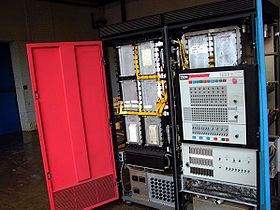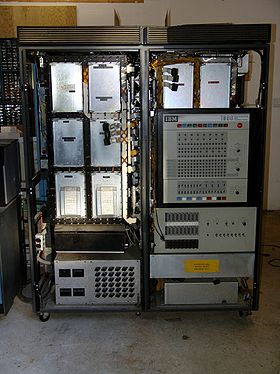
IBM 1800
Encyclopedia

Process control
Process control is a statistics and engineering discipline that deals with architectures, mechanisms and algorithms for maintaining the output of a specific process within a desired range...
variant of the IBM 1130
IBM 1130
The IBM 1130 Computing System was introduced in 1965. It was IBM's least-expensive computer to date, and was aimed at price-sensitive, computing-intensive technical markets like education and engineering. It succeeded the IBM 1620 in that market segment. The IBM 1800 was a process control variant...
with two extra instructions (CMP and DCM), extra I/O capabilities, 'selector channel like' cycle-stealing capability and three hardware index registers.
IBM announced and introduced the 1800 Data Acquisition and Control System on November 30, 1964, describing it as "a computer that can monitor an assembly line, control a steel-making process or analyze the precise status of a missile during test firing.".
Unlike the 1130, which was a desk-like unit, the 1800 is packaged in 6 foot high, EIA Standard 19 inch racks, which are somewhat taller than the racks used by S/360 systems of the same vintage, but the internal gates and power supplies were very much the same. Many 1800 cabinets show a distinct "ding" on the vents at the top of the chassis, where movers discovered that the door into a computer room was not quite tall enough for the 1800 cabinet.
The IBM 1500
IBM 1500
The IBM 1500 instructional system was introduced by IBM on March 31, 1966 and its primary purpose was to implement Computer Assisted Instruction . Based around either an IBM 1130 or an IBM 1800 computer, it supported up to 32 student work stations each with a variety of audiovisual...
instructional system was introduced by IBM on March 31, 1966 and was based around either an IBM 1130 or an IBM 1800 computer, it supported up to 32 student work stations each with a variety of audiovisual capabilities.
General
The IBM 1800 DACS consisted of:- D/A (Digital-to-Analog) Converter
- A/D (Analog-to-Digital) Converter
- IBM 1801 Processor Controller, with operator's panel
- IBM 1802 Processor Controller, with operator's panel, to include adapters for 2401/2402 Magnetic Tape Units.
- IBM 1803 Core Storage Addition
- IBM 1826 I/O Expansion Chassis (used for communications I/O, System/360 channels, 279x)
- IBM 1828 Process Expansion Unit (used for additional D/A or A/D converters, or to hold 1851 and/or 1854 multiplexors; there was an RPQ for a remote 1828 unit)
- IBM 1810 Disk (equivalent to 2310 on IBM 1130)
- IBM 1816 Printer Keyboard (System Printer)
- IBM 1851 Reed Relay Analog Multiplexor
- IBM 1854 Solid State Analog Mulitplexor
- IBM 1894 generic model number for many 1800 RPQ hardware features, which inter alia, included support for IBM 109x data entry devices)
- IBM 1053 Printer
- IBM 1054 Paper Tape Reader Unit
- IBM 1055 Paper Tape Punch Unit
- IBM 1442IBM 1442IBM 1442 was a combination IBM card reader and card punch. It read and punched 80-column IBM-format punched cards and was used on the IBM 1440, the IBM 1130, the IBM 1800 and System/360 and was an option on the IBM System/3. The 1442 could read up to 400 cards per minute. Cards were read and...
Card Reader/Punch Unit - IBM 1443 Printer
- IBM 1627IBM 1627The IBM 1627 was a rebranded Calcomp plotter sold by IBM for use with the IBM 1620, and, later, the IBM 1130 computers. It became perhaps the first non-IBM peripheral that IBM allowed to be attached to one of its computers....
Plotter - IBM 2401 or 2402 Magnetic Tape Unit (its adapter included in IBM 1802)
- IBM 2311 DASD (attached via an IBM 2841 Control Unit, latter attached to a channel in the IBM 1826), the MPX operating system could map two 1810 disks per 2311, the 1810 drive mapping being seen as a DSCB Form 5 dataset to S/360 OS)
- IBM 2260IBM 2260The text-only 960-character monochrome IBM 2260 cathode ray tube video display terminal plus computer keyboard was a 1964 predecessor to the more-powerful color text-and-graphics IBM 3270. The 2260 screen image was normally configured with 12 lines of 80 characters each, which corresponded to IBM...
CRT (attached via an IBM 2848 Control Unit, latter attached to a channel in the IBM 1826) - IBM 2790 Data Communication System, one of the earliest token ring type local area networks were attached and controlled by the IBM 1800.
(additional units being added)
Its use
The IBM 1800 systems were used mainly in the process industry plants worldwide, such as in the 1971 installation on Blast Furnace No. 5 of ChibaChiba Prefecture
is a prefecture of Japan located in the Kantō region and the Greater Tokyo Area. Its capital is Chiba City.- History :Chiba Prefecture was established on June 15, 1873 with the merger of Kisarazu Prefecture and Inba Prefecture...
Works of Kawasaki Steel Company
Kawasaki Heavy Industries
is an international corporation based in Japan. It has headquarters in both Chūō-ku, Kobe and Minato, Tokyo.The company is named after its founder Shōzō Kawasaki and has no connection with the city of Kawasaki, Kanagawa....
, now part of JFE Group
JFE Group
is a corporation headquartered in Tokyo, Japan. It was formed in 2002 by the merger of and . Both companies were major military vessel manufacturers during World War II....
.
British Aircraft Corporation (BAC) used three IBM 1800's at their Filton, Bristol plant. One system controlled the Concorde Fuel Test Rig, another controlled the Engine Nacelle Test Rig, the third IBM 1800 was Channel Attached to a large S/360 to number crunch the data collected from the other two systems.
In June 2010 the last four operating IBM 1800s operating at Pickering Nuclear Generating Station
Pickering Nuclear Generating Station
Pickering Nuclear Generating Station is a Canadian nuclear power station located on the north shore of Lake Ontario in Pickering, Ontario. The facility derives its name from the City of Pickering in which it is located....
in Pickering, Ontario
Pickering, Ontario
Pickering is a city located in Southern Ontario, Canada immediately east of Toronto in Durham Region. It is part of the Greater Toronto Area, the largest metropolitan area in Canada.- Early Period :...
, Canada
Canada
Canada is a North American country consisting of ten provinces and three territories. Located in the northern part of the continent, it extends from the Atlantic Ocean in the east to the Pacific Ocean in the west, and northward into the Arctic Ocean...
were removed from service. Pickering is still using four ES-1800 computers which are IBM 1800 hardware emulators built by Cable & Computer Technologies. A video showing the end of the Pickering IBM 1800 boot sequence is available on YouTube

See also
- IBM 1710IBM 1710The IBM 1710 was a process control system that IBM introduced in March 1961. It used either a 1620 I or a 1620 II Computer and specialized I/O devices .The IBM 1620 used in the 1710 system was modified in several ways, the most obvious was the addition of a very...
predecessor - IBM 7700 Data Acquisition SystemIBM 7700 Data Acquisition SystemThe IBM 7700 Data Acquisition System was announced by IBM on December 2, 1963.It was capable of collecting data from as many as 32 sources simultaneously, process the data and transmit results to up to 16 remote printers, display units or plot boards....
predecessor - IBM System/7IBM System/7The IBM System/7 was a computer system, designed in Boca Raton, Florida, and delivered in 1971. It was a 16-bit machine and one of the first made by IBM to use novel semiconductor memory, instead of magnetic core memory conventional at that date. IBM had earlier products in industrial control...
sensor only successor
External links
- IBM 1130.org which has significant information about the 1130 and 1800.
- Corestore.org which recently acquired an 1800 from a Canadian power plant and reports others are still in service.
- "Evolution of Small Real-Time IBM Computer Systems" (1.25 MB PDF file), from the IBM Journal of Research and Development.
- Opendragon site has two pictures of the 1800 in operation.
- IBM Archives: IBM 1800 — Process control variant of the 1130
- Bob Rosenbloom's IBM 1800 Photos

